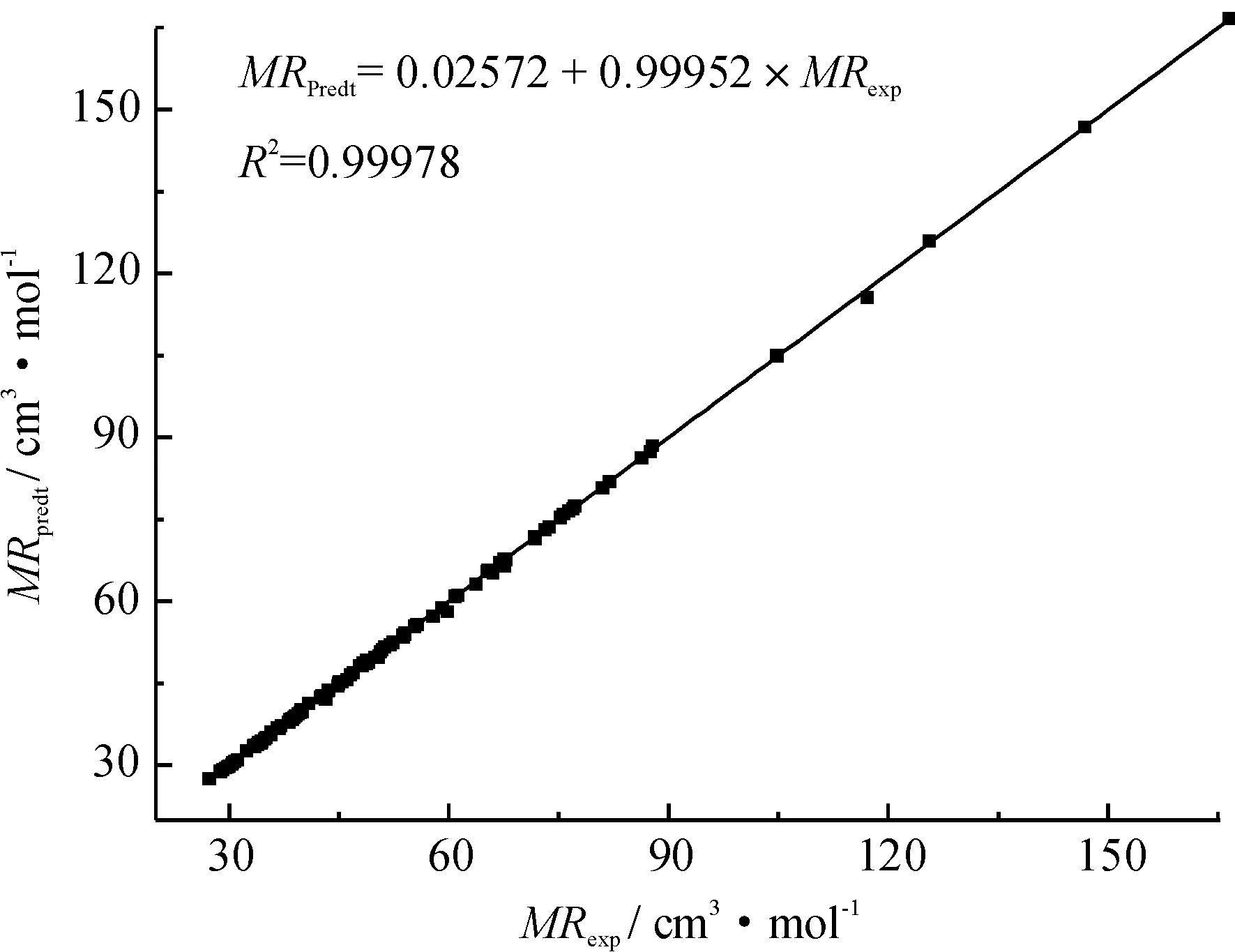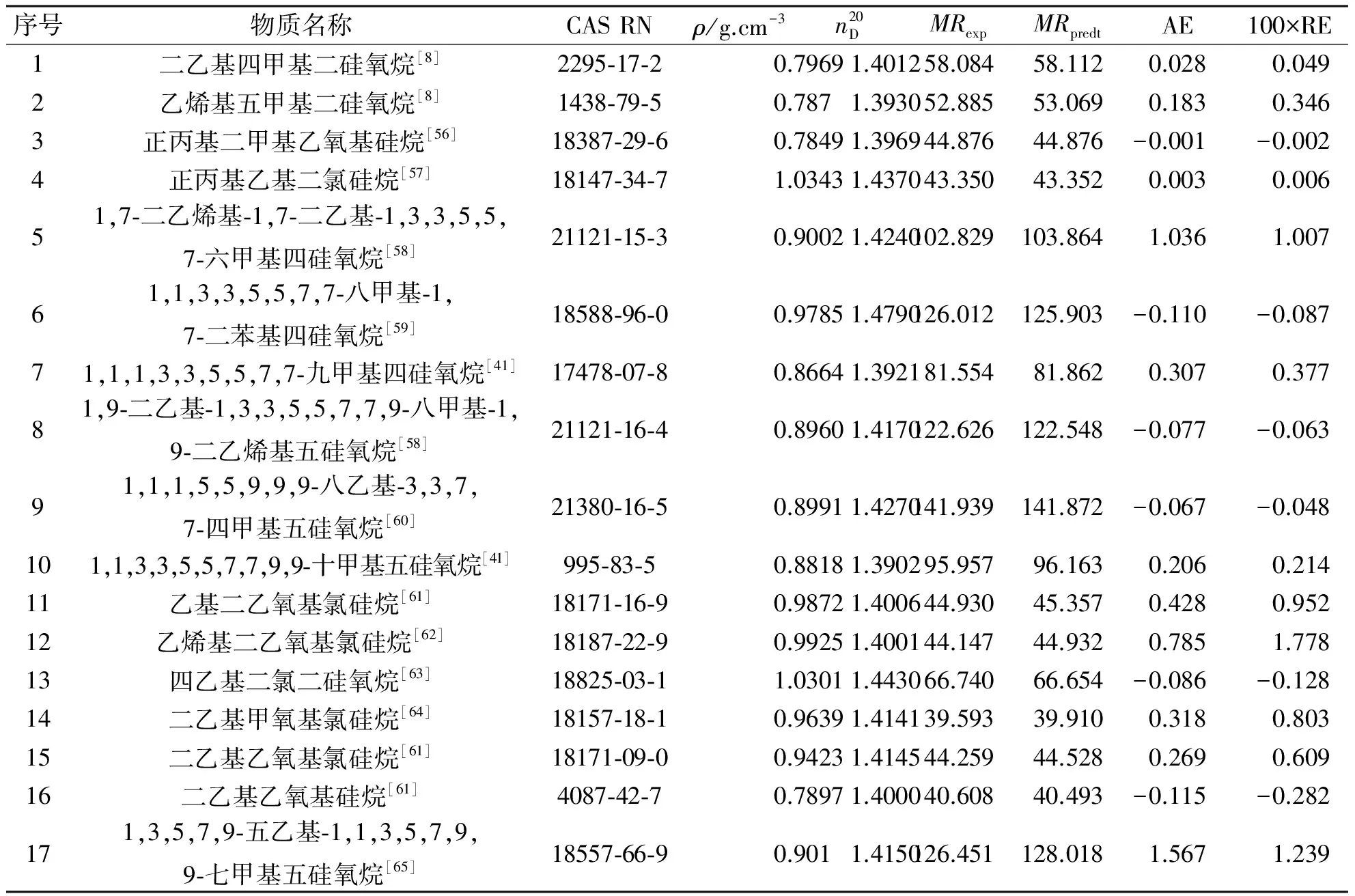原子贡献法估算硅烷及硅氧烷的摩尔折射度
2013-10-28程大海张引弟
程大海,伍 川,董 红,武 侠,张引弟
(杭州师范大学有机硅化学及材料技术教育部重点实验室,浙江 杭州 310012)
原子贡献法估算硅烷及硅氧烷的摩尔折射度
程大海,伍 川,董 红,武 侠,张引弟
(杭州师范大学有机硅化学及材料技术教育部重点实验室,浙江 杭州 310012)
根据硅烷和硅氧烷的分子结构,利用原子贡献法考察了中心Si原子及与其相连接的不同原子(C、H、Cl、O)和官能团(苯基和碳碳双键)的摩尔折射度,以110种硅烷和硅氧烷折射率和密度实验数据对建立的摩尔折射度估算方程进行了关联,利用SPSS 19.0软件对摩尔折射度方程组进行了拟合,得到上述原子和官能团的摩尔折射度数值,110种化合物摩尔折射度计算值与文献值之间的总体平均绝对误差、平均相对误差及均方根误差分别为0.227 cm3.mol-1、0.433%及0.369 cm3·mol-1,为已知结构有机硅新化合物折射率的预测或特定折射率有机硅化合物的设计合成提供了依据.
原子贡献法;摩尔折射度;硅烷;硅氧烷;估算
前 言
物质微观结构与宏观性能之间的关系一直是化学及材料领域关注的焦点.按照分子内原子或官能团的组成及相互作用,已采用原子贡献法、基团贡献法和化学键贡献法对各种碳系化合物的摩尔体积、摩尔折射度等具有强度性质的状态函数进行了广泛研究,在此基础上可准确预测烷烃、芳烃、脂肪醇和硫醇等碳系化合物的折射率等光学性能[1-2].假定原子对物质某一特性的贡献在不同溶液环境中不变,那么任一纯物质或者混合物的某一特性都是由构成其所有原子的贡献之和.人类已合成的化合物数以万计,但这些化合物均由少数几种原子构成.即使加和规则只是近似成立,但通过对少量纯物质或混合物的实验数据进行拟合,回归得到构成物质原子特性的贡献值或参数值,则可依据加和规则对物性参数未知的含有同类原子的其它纯物质或混合物的有关性质进行预测,从而大大减少人、财、物和时间的消耗,用最少的实验工作量获得最大的效果[3].例如,利用摩尔折射度的加和性质,可由组成化合物的原子种类和数量及官能团的属性预测目标化合物的折射率,为开发高折射率的光学材料提供有益指导[4].硅烷及以硅氧烷为骨架结构的有机硅聚合物自20世纪40年代实现工业化生产以来,以其优异的光学、热性能及耐辐射性能广泛应用于各个领域,成为不可替代的新材料.虽然碳和硅元素同属IVA族元素,但两者原子半径、电负性及价层空轨道差异较大,尤其是硅原子d轨道可通过sp3d或sp3d2等杂化轨道形式参与成键,具有很强的pπ-dπ作用,因此,硅烷和硅氧烷等有机硅化合物与碳系化合物性质明显不同,不能利用以碳系化合物为分子模型推导的各原子或官能团的贡献值对有机硅化合物的热力学性质进行预测.相对于碳系化合物,有机硅化合物微观结构与宏观性质的研究较少,文献中虽报道了采用分子连接性预测硅烷的摩尔折射度[1-2,5-6],但仅仅局限于烷基硅烷化合物,对于取代硅烷及硅氧烷化合物微观结构与摩尔折射度和摩尔体积等热力学性质的关系研究则鲜见报道.本文采用原子贡献法研究了硅烷、取代硅烷及低聚二硅氧烷分子结构与其摩尔折射度的关系.
1 基本原理和方法
硅原子通常采用sp3杂化方式形成4个σ成键轨道,可与4个原子相连接,但硅原子除s和p轨道外,还有5个空3 d轨道可形成pπ-dπ共价键.因此,当硅原子作为中心原子时,与硅直接相连的4个原子所处的化学环境不同于碳原子作为中心原子时,导致这些原子对于有机硅化合物摩尔折射度的贡献值发生变化.碳系化合物中部分原子摩尔折射度的数值已被报道[4],如果仅仅考虑硅原子对紧邻的4个原子(α位置)的影响而忽略与其分子间距更远的β和γ位置原子与硅原子的相互作用,以已确定的碳系化合物中各原子的摩尔折射度为基础,通过对各原子摩尔折射度数值进行修正以消除中心的硅原子和碳原子化学环境差异对于有机硅化合物折射率的影响,则可计算得到有机硅化合物中各个原子、双键和苯基官能团的摩尔折射度,进而可建立有机硅化合物或聚合物微观组成结构与宏观折射率之间的联系.

表1 硅烷及硅氧烷分子中原子修正值的定义
从有机硅化合物的结构分析可知,与Si原子直接相连的O原子主要包括Si-O-C和Si-O-Si两种.假定两种氧原子摩尔折射度的修正值分别为d和h, Si原子的摩尔折射度为a,与Si原子直接相连的C原子、Cl原子、H原子、苯基和双键的修正值分别为b、c、e、f和g,如表1所示.以甲基三甲氧基硅烷(CH3Si(OCH3)3)为例,该化合物分子中,与中心Si原子直接相连的有3个O原子和1个C原子,由碳系化合物回归得到的C原子、H原子、O原子的摩尔折射度数值分别为2.418、1.100和1.643 cm3.mol-1[4],因此甲基三甲氧基硅烷的摩尔折射度可表示为MR=a+2.418×4+1.100×12+1.643×3+b+3×d.
物质的折射率(nD)与摩尔折射度(MR)之间的关系可用Lorentz-Lorenz经验方程进行定量描述(式(1))[4]:
(1)
摩尔折射度(MR)虽为热力学强度性质,但具有加和性,与组成化合物的原子、分子或基团的种类及数量有关,如式(2)所示:
(2)
式中n(Gi)、Gi分别为构成硅烷分子的原子数目及其对于摩尔折射度的贡献值.
采用式(3)计算摩尔折射度(MR)文献值与计算值之间的均方根误差(RMSD):
(3)
式中n为摩尔折射度参数回归方程组中化合物的数目,m为回归方程组中回归参数的数目.
2 计算结果及讨论
以表2所示110种硅烷和硅氧烷化合物作为样本,利用已报道的碳系化合物中原子摩尔折射度的数据[4],采用原子贡献法研究硅烷化合物中分子结构与摩尔折射度之间的关系.利用文献值按式(1)计算各有机硅化合物的摩尔折射度(MRexp),对每一样本化合物采用式(2)描述原子和官能团种类和数量与化合物摩尔折射度之间的关系,构成由110个多元一次线性方程形成的方程组,采用SPSS 19.0数理统计软件对方程组进行回归拟合,利用学生t-分布的区间估计公式,计算得到各原子和基团摩尔折射度的修正值及其在置信水平为0.95上的置信区间(见表3).

表2 110种硅烷及硅氧烷化合物的摩尔折射度
注:RE=(MRpredt-MRexp)/MRexp

表3 有机硅化合物各原子和基团摩尔折射度计算结果
备注:MR′为碳系化合物中各原子和官能团的摩尔折射度
利用回归得到的各原子和基团摩尔折射度修正值,由硅烷或硅氧烷分子结构出发,计算得到各化合物的摩尔折射度(MRpredt).例如,甲基三氯硅烷(CH3SiCl3)的摩尔折射度表达式为:
MRpredt=a+2.418+b+1.100×3+5.967×3+3×c
将回归得到的修正值a=8.304,b=-0.246,c=-0.842代入上式计算得到甲基三氯硅烷的摩尔折射度MRpredt=29.151 cm3.mol-1,与实验值MRexp=29.110 cm3.mol-1非常接近,两者之间的相对误差仅为-0.141%.分别计算110个样本的摩尔折射度数值(MRpredt)并与实验值进行对比,结果列于表2中,计算值与实验值之间的总体平均绝对误差、平均相对误差及均方根误差分别为0.227 cm3.mol-1、0.433%及0.369 cm3·mol-1,可见摩尔折射度预测值与实验值之间的偏差小,两者之间的一致性令人满意(见图1).
为进一步验证原子贡献法估算得到各原子及苯基和乙烯基官能团的摩尔折射度,任意选取17种化合物,计算其摩尔折射度并与文献计算值进行对比,结果如表4和图2所示.17个样本预测结果的平均绝对误差为0.329 cm3.mol-1、平均相对误差为0.470%、均方根误差为0.724 cm3.mol-1.可见预测值与实验值的一致性令人满意.

图1 摩尔折射度预测值与实验值的比较Fig. 1 Comparisons between predicted and experimental values for molar refraction

图2 17种有机硅化合物摩尔折射度预测值与实验值的比较Fig. 2 Comparisons between predicted and experimental values of molar refraction for 17 kinds of silicone compounds
表4有机硅化合物摩尔折射度的验证
Tab.4Verificationofmolarrefractionforsiliconecompounds

序号物质名称CASRNρ/g.cm-3n20DMRexpMRpredtAE100×RE1二乙基四甲基二硅氧烷[8]2295⁃17⁃20.79691.401258.08458.1120.0280.0492乙烯基五甲基二硅氧烷[8]1438⁃79⁃50.7871.393052.88553.0690.1830.3463正丙基二甲基乙氧基硅烷[56]18387⁃29⁃60.78491.396944.87644.876-0.001-0.0024正丙基乙基二氯硅烷[57]18147⁃34⁃71.03431.437043.35043.3520.0030.00651,7⁃二乙烯基⁃1,7⁃二乙基⁃1,3,3,5,5,7⁃六甲基四硅氧烷[58]21121⁃15⁃30.90021.4240102.829103.8641.0361.00761,1,3,3,5,5,7,7⁃八甲基⁃1,7⁃二苯基四硅氧烷[59]18588⁃96⁃00.97851.4790126.012125.903-0.110-0.08771,1,1,3,3,5,5,7,7⁃九甲基四硅氧烷[41]17478⁃07⁃80.86641.392181.55481.8620.3070.37781,9⁃二乙基⁃1,3,3,5,5,7,7,9⁃八甲基⁃1,9⁃二乙烯基五硅氧烷[58]21121⁃16⁃40.89601.4170122.626122.548-0.077-0.06391,1,1,5,5,9,9,9⁃八乙基⁃3,3,7,7⁃四甲基五硅氧烷[60]21380⁃16⁃50.89911.4270141.939141.872-0.067-0.048101,1,3,3,5,5,7,7,9,9⁃十甲基五硅氧烷[41]995⁃83⁃50.88181.390295.95796.1630.2060.21411乙基二乙氧基氯硅烷[61]18171⁃16⁃90.98721.400644.93045.3570.4280.95212乙烯基二乙氧基氯硅烷[62]18187⁃22⁃90.99251.400144.14744.9320.7851.77813四乙基二氯二硅氧烷[63]18825⁃03⁃11.03011.443066.74066.654-0.086-0.12814二乙基甲氧基氯硅烷[64]18157⁃18⁃10.96391.414139.59339.9100.3180.80315二乙基乙氧基氯硅烷[61]18171⁃09⁃00.94231.414544.25944.5280.2690.60916二乙基乙氧基硅烷[61]4087⁃42⁃70.78971.400040.60840.493-0.115-0.282171,3,5,7,9⁃五乙基⁃1,1,3,5,7,9,9⁃七甲基五硅氧烷[65]18557⁃66⁃90.9011.4150126.451128.0181.5671.239
注:AE=MRexp-MRpredt
由表3和表4及图1和图2可以看出,含有苯基或乙烯基的硅烷和硅氧烷的摩尔折射度预测值与实验值之间的误差较大,这是由于计算过程中将苯基与双键当作单个原子进行了简化处理,实际上,苯基和双键与中心Si原子之间存在更为复杂的pπ-dπ作用,若忽略苯基和双键中β和γ位置上其它原子对于中心Si原子的长程作用,将导致含苯基或乙烯基的硅烷和硅氧烷的摩尔折射度及摩尔体积预测值与实验值之间出现较大的误差.
3 结 论
根据硅烷和硅氧烷分子的结构,对其进行合理拆分,在文献报道的碳系化合物原子摩尔折射度数值基础上,对与硅原子直接相连的原子和基团进行修正,通过回归分析得到Si、Cl、H、C、C=C、O(Si—O—C中)、O(Si—O—Si中)及苯环的摩尔折射度数值;除含苯环和C=C双键的有机硅化合物外,计算得到的原子摩尔折射度数值可成功用于有机硅化合物摩尔折射度的预测,预测值与实验值之间相对误差较小,为已知结构有机硅新化合物折射率的预测或特定折射率的有机硅化合物的设计合成提供了有力工具.
[1] 王克强.硅烷摩尔折射度与其分子结构之间关系的探讨[J].有机化学,1994,14(3):269-274.
[2]王克强.应用基团键贡献法预测烷烃、脂肪醇和硫醇的摩尔折射度[J].韩山师范学院学报,2000,21(2):66-70.
[3] 王从岗,陈泽辉,富嘉文,等.基团贡献法预测石油馏分热力学性质的探索[J].石油炼制与化工,1993,24(5):57-64.
[4] Speight J G. Lange’s Handbook of Chemistry[M]. 16th ed. New York: McGraw-Hill Companies, Inc.,2004.
[5] Kupchik E J. Structure-Molar Refraction Relationships of Alkylsilanes Using Molecular Connectivity[J].Quantitative structure-activity relationships in pharmacology, chemistry, and biology,1985,4(3):123-127.
[6] Hall L H, Aaserud D. Structure-activity models for molar refraction of alkylsilanes based on molecular connectivity[J]. Quantitative Structure-Activity Relationships,1989,8(4):296-304.
[7] Krolevets A A. New syntheses of alkoxysilanes and their properties[J]. Zhurnal Obshchei Khimii,1988,58(10):2274-2281.
[8] Metal-Organics Catalog[M]. Gelest, Inc.: Morrisville, PA,2007.
[9] Dolgov B N, Voronkov M G, Borisov S N. Catalytic transformations of alkyldichlorosilanes and dialkylchlorosilanes in the presence of aluminum chloride [J]. Zhurnal Obshchei Khimii,1957,27:709-716.
[10] Kanazashi M. Unsaturated organosilicon compounds. II. Reactions and properties of vinyltrimethylsilane [J]. Bulletin of the Chemical Society of Japan,1955,28(1):44-50.
[11] Borisov S N, Sviridova N G. Cleavage of siloxanes by halosilanes. A new method of synthesis of organosiloxanes[J]. Zhurnal Obshchei Khimii,1959,29:1534-1541.
[12] Freidlina R K, Chukovskaya E T, Tsao I. Addition of silanes to unsaturated compounds in the presence of iron pentacarbonyl[J]. Doklady Akademii Nauk SSSR,1959,127:352-355.
[13] Dolgov B N, Borisov S N, Voronkov M G. Reaction of dialkylchlorosilanes with aluminum chloride[J]. Zhurnal Obshchei Khimii,1957,27:2062-2066.
[14] Valade J, Calas R, Mileo J C. Organosilicon chemistry. Preparation of trialkylchlorosilanes[J]. Compt Rend.1959,249:1769-1770.
[15] Nametkin N C, Sorokin G V, Pozdnyakova M V,etal. Polymerization of ethylene with the titanium tetrachloride-trialkyl aluminum-trialkylsilane systems[J]. Vysokomolekulyarnye Soedineniya, Seriya B: Kratkie Soobshcheniya,1968,10(1):53-55.
[16] Petrov A D. Synthesis of α-trimethylsilylstyrene, 1-trimethylsilylcyclohexene, and other unsaturated organosilicon compounds[J]. Zhurnal Obshchei Khimii,1957,27:1535-1539.
[17] Dolgov B N, Vinter G, Komarov V A,etal. Reaction of pentaerythritol with trialkylsilanes in presence of certain metal halides[J]. Bulletin of the Academy of Sciences of the USSR, Division of chemical science,1963,12(12):1978-1983.
[18] Sheludyakov V D. Characteristics of hydrochlorination of vinylsilanes with several vinyl groups at the silicon atom[J]. Zhurnal Obshchei Khimii,1985,55:1345-1350.
[19] Vaisarova V, Chvalovsky V. Organosilicon compounds. LVI. Dipole moments of substituted vinylsilanes and phenylsilanes[J]. Collection of Czechoslovak Chemical Communications,1968,33(3):859-865.
[20] Voronkov M G. Acetylene hydrosilylation reaction[J]. Doklady Akademii Nauk SSSR,1980,254:887-890.
[21] Mironov V F. Relative reactivity of some alkenylsilanes with trichlorosilane[J]. Izvestiya Akademii Nauk SSSR, Seriya Khimicheskaya,1960,4:760-762.
[22] Sommer L H, Bailey D L, Goldberg G M. Vinylsilanes, chlorovinylsilanes, and β-styryltrimethylsilane. Further studies on the α-silicon effect and β-eliminations involving silicon [J]. Journal of the American Chemical Society,1954,76(6):1613-1618.
[23] Kanazashi M. Unsaturated organosilicon compounds. I. Synthesis of organovinylsilanes by Wurtz-Fittig reaction[J]. Bulletin of the Chemical Society of Japan,1953,26(9):493-496.
[24] Steiling L, Wannagat U. Sila drugs, 15. Synthesis and properties of silapridinol[J]. Zeitschrift fuer Naturforschung, Teil B: Anorganische Chemie, Organische Chemie,1979,34B:1413-1417.
[25] Mironov V F, Petrov A D, Maksimova N G. Organomagnesium synthesis of 2-and 3-(Trimethylsilyl) acrylic acids and vinyl derivatives of silicon, germanium, and tin[J]. Russian Chemical Bulletin,1959,8(11):1864-1870.
[26] Sheludyakov V D, Zhun V I, Polyakova M V,etal. Some data on the synthesis of vinylsilanes[J]. Zhurnal Obshchei Khimii Some data on the synthesis of vinylsilanes,1980,50(4):868-871.
[27] Zakharkin L I. Reduction of alkylc hlorosilanes with sodium hydride in the presence of triethylaluminum[J]. Russian Chemical Bulletin,1960,9(12):2079-2080.
[28] Molchanova T V, Kopylov A I, Burde N L,etal. Synthesis of some aromatic silanes[J]. Trudy Khimiko-Metallurgicheskogo Instituta, Akademiya Nauk Kazakhskoi SSR,1966,13:17-24.
[29] Lehnert R, Porzel A, Ruehlmann K. Preparation of siloxanes. 9. Position of the equilibrium chlorodimethylphenylsilane+water .dblharw. hydroxydimethylphenylsilane+hydrochloric acid in dioxane-benzene-d6[J]. Zeitschrift fuer Chemie,1988,28(5):190-192.
[30] Ruehlmann K, Grosse-Ruyken H, Scheller D,etal. Synthesis of siloxanes. XIV. Reaction of chlorosilanes with silanols in acid medium [J]. Journal of Organometallic Chemistry,1988,356(1):39-47.
[31] Malnova G N, Mikheev E P, Klebansky A L,etal. Catalytic phenylation of hydrogen-containing alkylchlorosilanes with benzene[J]. Doklady Akademii Nauk SSSR,1957,117:623-625.
[32] Westermark H. Preparation of some organic silicon hydrides[J]. Acta Chemica Scandinavica,1954,8(10):1830-1834.
[33] Smith B. Silico ovrddot organic compounds[J]. Doktorsavhandl. Chalmers Tek Hogskola,1951,6:154.
[34] Lukevics E, Pudova O A, Dzintara M. Organometallic derivatives of sulfur-containing heterocycles. XIII. Dehydrocondensation of thienylsilanes with hydroxyl-containing compounds in the presence of organic bases[J]. Zhurnal Obshchei Khimii,1984,54(2):339-342.
[35] Koristek S, Langner J, Cermak J. Preparing organoalkoxysilanes and organoaryloxysilanes: Czech, CS 122624[P].1967-04-15.
[36] Voronkov M G. Alkoxysilanes. XIII. Reaction of siloxanes with alkoxysilanes. New method of synthesis of alkoxysilanes and siloxanes[J]. Zhurnal Obshchei Khimii,1959,29:907-915.
[37] Andrianov K A, Delazari N V. Reactions of chloro (trimethylsiloxy) silanes[J]. Russian Chemical Bulletin,1961,10(12):2028-2031.
[38] Müller R, Köhne R, Sliwinski S.etal. Methylsiloxanes with Si-H bonds[J]. Journal fuer Praktische Chemie (Leipzig),1960,11:336-340.
[39] Tanaka T, Tasaka A, Okawara R,etal. Lower members of methylmethoxypolysiloxanes with one to five silicon atoms[J]. Technology Reports of the Osaka University,1957,7:193-197.
[40] Krolevets A A, Antipova V V, Popov A G,etal. New syntheses of alkoxysilanes and their properties[J]. Zhurnal Obshchei Khimii,1988,58(10):2274-2281.
[41] Greber G, Metzinger L. Polysiloxane hydrides: DE, 1085875[P].1960-07-28.
[42] Lebedev E P, Fedorov A D. Cocondensation of organodisilazanes and organochlorosilanes with organosilanols and siloxanols[J]. Zhurnal Obshchei Khimii,1979,49(1):147-150.
[43] Kovalev I F, Ozolins L, Voronkov M G,etal. Integral intensities and depolarization ratios of Raman lines of (CH3)3SiOSi(CH3)3, (CH3)3SiOC(CH3)3, and (CH3)3COC(CH3)3[J]. Akademiya Nauk SSSR, Otdelenie Fiziko-Matematicheskikh Nauk,1967,3:301-307.
[44] Andreev D N, Kukharskaya E V. Condensation of hexamethyldisiloxane in a high-voltage silent discharge of sonic frequency[J]. Doklady Akademii Nauk SSSR,1960,134:817-820.
[45] Mironov I V, Siraeva I N, Kiladze T K,etal. Hydrosilylation of 4,4-dimethyl-1,3-dioxane[J]. Zhurnal Obshchei Khimii,1981,51(12):2700-2704.
[46] Andrianov K A, Kochetkova A S, Khananashvili L M. Copolymerization of methylvinylsiloxane oligomers with methylhydridosiloxanes[J]. Zhurnal Obshchei Khimii,1968,38(1):175-178.
[47] Petrov A D, Vdovin V M. Reaction of symmetric tetraalkyldisiloxanes with dialkyldialkenylsilanes and symmetric tetraalkyldialkenyldisiloxanes[J]. Izvestiya Akademii Nauk SSSR, Seriya Khimicheskaya,1959,4:939-941.
[48] McCusker P A, Ostdick T. Reactions of haloboranes with organocyclosiloxanes. I. Boron chloride with methyl and ethyl trimer and tetramer[J]. Journal of the American Chemical Society,1958,80(5):1103-1106.
[49] Borisov S N, Sviridova N G, Orlova V S. Reaction of silanols with hydrosilanes[J]. Zhurnal Obshchei Khimii,1966,36(4):687-692.
[50] Sliwinski S. Silicones. XCVI. Preparation of 1,3,3,5-tetramethyl-1,1,5,5-tetraphenyl- and 1,3,5-trimethyl-1,1,3,5,5-pentaphenyltrisiloxane[J]. Journal fuer Praktische Chemie (Leipzig),1966,32(1-2):31-36.
[51] Andreev D N, Lavrinovich L I. Resistance of Si-C bonds in dimethyldialkylsilanes to the action of sulfuric acid[J]. Zhurnal Obshchei Khimii,1968,38(12):2743-2751.
[52] Topchiev A V, Nametkin N S, Kartasheva L I. Reaction of ethyl bromide with silicon[J]. Russian Chemical Bulletin,1958,7(8):922-925.
[53] Sadykh-Zade S I, Petrov A D. Synthesis and reactions of butadienylsilanes[J]. Zhurnal Obshchei Khimii,1958,28:1542-1547.
[54] Patnode W I, Wilcock D F. Methylpolysiloxanes[J]. Journal of the American Chemical Society,1946,68:358-363.
[55] Borisov S N, Voronkov M G, Dolgov B N. The disproportionation of trialkylsilanes[J]. Bulletin of the Academy of Sciences of the USSR, Division of chemical science,1957,6(11):1416-1418.
[56] Westermark H. The exchange of ethoxy groups in methylethoxysilanes for alkyl groups[J]. Svensk Kemisk Tidskrift,1952,64:283-284.
[57] Ponomarenko V A, Sokolov B A, Petrov A D. Addition of methyldichlorosilane and ethyldichlorosilane to allyl halides[J]. Doklady Akademii Nauk SSSR,1956,106:76-79.
[58] Andrianov K A, Gavrikova L A, Rodionova E F. Synthesis and investigation of polymerization reactions of divinylsiloxane oligomers and their copolymerization with isoprene[J]. Izvestiya Akademii Nauk SSSR, Seriya Khimicheskaya,1968,8:1786-1791.
[59] Brevnova T N, Semenov V V. Oxidation of 1-phenyl-2-chlorotetramethyldisilane by peroxide compounds[J]. Zhurnal Obshchei Khimii,1979,49(1):142-147.
[60] Andrianov K A, Nogaideli A I, Nakaidze L I. Reaction of 1,5-dihydroorganotrisiloxanes with organohydroxysilanes[J]. Izvestiya Akademii Nauk SSSR, Seriya Khimicheskaya,1968,9:2146-2147.
[61] Kumada M. Preparation of ethoxychlorosilanes and their alkyl derivatives by ethoxy-chlorine interconversions[J]. Journal of the Institute of Polytechnics, Osaka City University,1952,2(Ser.C):139-146.
[62] Alksne V, Grinevich K P. Alkenylalkoxychlorosilanes[J]. Latvijas PSR Zinatnu Akademijas Vestis, Kimijas Serija,1964,(2):249-252.
[63] McCusker P A, Ostdick T. Reactions of haloboranes with organocyclosiloxanes. I. Boron chloride with methyl and ethyl trimer and tetramer[J]. Journal of the American Chemical Society,1958,80:1103-1106.
[64] Andrianov K A, Zhdanov A A, Kashutina E A. Reaction of diethylmethoxychlorosilane with sodium derivatives of acetylacetone and acetoacetic ester[J]. Zhurnal Obshchei Khimii,1962,32:297-301.
[65] Dow Corning LTD. Improvements in or relating to the manufacture of co-polymeric siloxanes: GB, 659012[P].1951-10-17.
TheMolarRefractionEstimationofSilanesandSiloxanesbyAtomContributionMethod
CHENG Dahai, WU Chuan, DONG Hong, WU Xia, ZHANG Yindi
(Key Laboratory of Organosilicon Chemistry and Material Technology, Ministry of Education, Hangzhou Normal University,Hangzhou 310012, China)
The molar refraction of the central Si atom and different atoms (C, H, O, Cl) as well as or functional groups (phenyl group and C=C double bond) that directly connected with the central Si atom in silane or siloxane molecules was investigated by atom contribution method. The molar refraction values and density experimental data of 110 kinds of silanes and siloxanes were used to correlate with the established estimation formula of molar refraction. The equation set of molar refraction was fitted by SPSS 19.0 software and the values of molar refraction of each studied atoms and groups were estimated. The overall mean absolute error, the mean relative error and the root-mean-square deviation between the estimated and calculated values of the molar refraction of 110 kinds of chemicals were 0.227 cm3.mol-1, 0.433% and 0.369 cm3·mol-1, respectively. The results are beneficial to the prediction of the refractive index of the novel silicone compounds with known structure or the design and synthesis of the novel silicone compounds with specific refractive index.
atom contribution method; molar refraction; silane; siloxane; estimation
2013-05-10
浙江省公益技术应用研究资助项目(2011C21026);石油和化工行业科技指导计划资助项目(2011-07-06).
伍 川(1970—),男,研究员,主要从事有机硅树脂研究.E-mail:catalyst88@163.com
10.3969/j.issn.1674-232X.2013.05.003
O642.1
A
1674-232X(2013)05-0395-09
